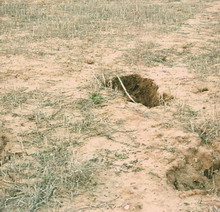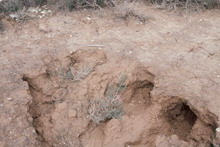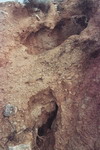|
|
DEGRADATION AND CONTROL PROCESSES |
|
Degradation process:
|
Tunnel erosion, piping and suffusion.
|
Description:
|
Erosion takes place at the sub-surface level. The circulation of excess water through animal burrows, cracks, poorly compacted embankments or old root holes, in a soil which has loose subsurface matter, produces subsurface erosion with serious consequences. Water entering the soil leads to the suspension of the loose matter and the mud subsequently formed may move. If the tunnel has an exit hole, the water flow will progressively increase the size of the tunnel, which may cause the overlying ground to collapse.
Importance: occasional.
|
Click on the image

Tunnel erosion or piping: entrance hole
(R. M. Poch)
|
Soil functions affected:
|
Biomass production (reduction of crop yields and the need for greater inputs), environmental functions (filtration), hydrological function, reduction of carbon sequestration, functions for preventing offsite effects (sediment supply during floods, silting up of dams), function of supporting built infrastructure and constructions.
|
Diagnostic criteria:
|
Presence of water entrance holes and exit holes in talus near the entrance. They initially tend to be quite inconspicuous and only become apparent when the land suddenly collapses.
|
Click on the image

Tunnel erosion or piping: exit hole and collapse. Les Garrigues (J. Porta)
|
Click on the image

Tunnel erosion or piping: entrance and exit holes
(R. M. Poch)
|
Prevention and control:
|
Each case must be studied individually because it is difficult to generalize about the most effective corrective measures (mechanical, chemical and biological) and they are rarely effective.
|
|
<< back |
|
|
|